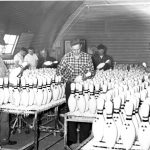By the year 1904, when the “Armeda” toilet pictured here appeared in the Kohler Company’s product catalogue, Sheboygan-based Kohler had become one of the largest makers of bathroom furnishings in the United States. Even at this early date in its history, as this catalogue illustration shows, the company sought to position itself at the luxury end of the booming market in the construction of new homes.
The Armeda was fitted together from a cast-iron toilet bowl that had been enameled with a porcelain coating. The water tank that flushed water into the toilet could be suspended in a low position behind the toilet, as pictured here, or positioned higher on the wall. When positioned high on a wall, a chain hung on the outside of the tank, which could be pulled to empty the tank and flush the toilet.

As expected from the luxury market they were designed for, Kohler toilets were expensive. Equipped with the “piano oak” finish for seat, cover, and water tank, as pictured here, a toilet with a low water tank cost $28.50 in 1904, equivalent to nearly $900 today. (By comparison, the toilets sold by Kohler and its competitors in 2022 typically range from $250-$400.) Further emphasizing the Armeda’s luxury brand, Kohler offered its customers a choice of wood finishes beside oak, including cherry, hickory, “Bird’s Eye Maple” — even mahogany. The latter option cost an extra $8.00.
To discerning eyes, one distinctive feature of toilets from a century ago was their S-shaped base. The shape does not merely represent a choice in design. Instead, it displays the insertion of a trap below the bowl at the base of the toilet, in which some water would remain after flushing. The trap was meant to protect the bathroom and the rest of the household space from the spread of “sewer gas,” which in the later 19th and early 20th centuries was widely feared as a potential cause of disease in places that had sewer systems.

Written by Thomas Broman, January 2022
SOURCE
Kohler Catalog, Kohler Co. Archives.




